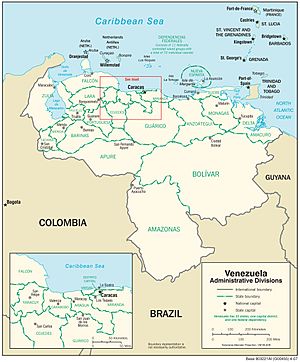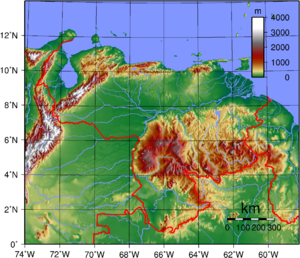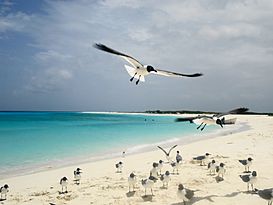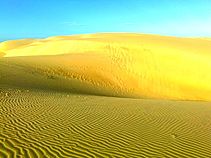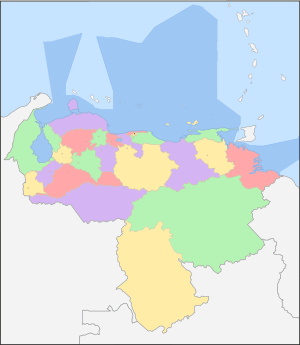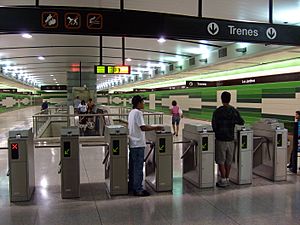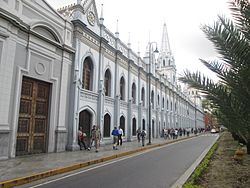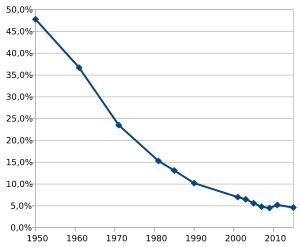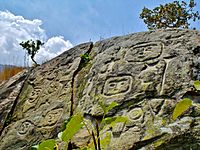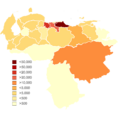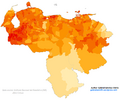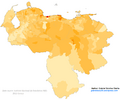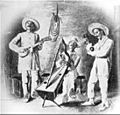Venezuela facts for kids
Quick facts for kids
Bolivarian Republic of Venezuela
República Bolivariana de Venezuela (Spanish)
|
|
|---|---|
|
Motto: Dios y Federación
("God and Federation") |
|
|
Anthem: Gloria al Bravo Pueblo (Spanish)
("Glory to the Brave People") |
|
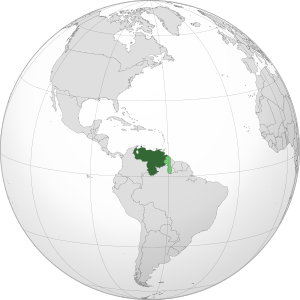 Location on the Western Hemisphere Location on the Western HemisphereLand controlled by Venezuela shown in dark green; claimed but uncontrolled land shown in light green.
|
|
| Capital and largest city
|
Caracas 10°30′N 66°55′W / 10.500°N 66.917°W |
| Official languages | Spanish |
| Recognized regional languages |
26 languages
Piapoco
Baniwa Locono Wayúu Warao Pemón Panare Yek'uana Yukpa Carib Akawaio Japrería Mapoyo Yawarana Hodï Puinave Jivi Barí Uruak Sapé Pumé Piaroa Yanomamö Sanemá Yanam Yeral |
| Ethnic groups
(2011)
|
|
| Religion
(2020)
|
|
| Demonym(s) | Venezuelan |
| Government | Federal presidential republic under a centralized authoritarian state |
| Nicolás Maduro | |
| Delcy Rodríguez | |
| Legislature | National Assembly |
| Independence from Spain | |
|
• Declared
|
5 July 1811 |
|
• from Gran Colombia
|
13 January 1830 |
|
• Recognized
|
29 March 1845 |
|
• Current constitution
|
20 December 1999 |
| Area | |
|
• Total
|
916,445 km2 (353,841 sq mi) (32nd) |
|
• Water (%)
|
3.2% |
| Population | |
|
• 2023 estimate
|
30,518,260 (50th) |
|
• Density
|
33.74/km2 (87.4/sq mi) (144st) |
| GDP (PPP) | 2022 estimate |
|
• Total
|
|
|
• Per capita
|
|
| GDP (nominal) | 2022 estimate |
|
• Total
|
|
|
• Per capita
|
|
| Gini (2013) | ▲ 44.8 medium |
| HDI (2021) | medium · 120th |
| Currency | Venezuelan bolívar (official) United States dollar (de-facto recognised, unofficial) |
| Time zone | UTC−4 (VET) |
| Date format | dd/mm/yyyy (CE) |
| Driving side | right |
| Calling code | +58 |
| ISO 3166 code | VE |
| Internet TLD | .ve |
|
|
Venezuela (VEN-ə-ZWAY-lə), officially the Bolivarian Republic of Venezuela, is a country located on the northern coast of South America. It covers an area of about 916,445 square kilometers (353,841 square miles). In 2022, its population was estimated to be around 29 million people. The country's capital and largest city is Caracas.
Venezuela is a founding member of many important international groups. These include the United Nations (UN), the Organization of American States (OAS), and Mercosur. It is also part of the Union of South American Nations (UNASUR) and the Bolivarian Alliance for the Peoples of Our America (ALBA).
Contents
- Venezuela's Borders
- A Brief History of Venezuela
- What's in a Name? The Etymology of Venezuela
- Exploring Venezuela's Geography
- How Venezuela is Governed
- How Venezuela is Divided
- Tourism in Venezuela
- Getting Around: Transport in Venezuela
- People and Their Background: Ethnicity in Venezuela
- Languages Spoken in Venezuela
- Religion in Venezuela
- Education in Venezuela
- Venezuelan Culture
- Official Holidays in Venezuela
- Popular Holidays in Venezuela
- Fun Facts About Venezuela
- Images for kids
- See also
Venezuela's Borders
Venezuela shares its borders with several neighbors. To the north, it meets the Caribbean Sea and the Atlantic Ocean. To the west, it borders Colombia, and to the south, it borders Brazil. To the north-east, it is close to Trinidad and Tobago, and to the east, it borders Guyana. Venezuela is a presidential republic. It is made up of 23 states, a Capital District (where Caracas is located), and federal dependencies which are its offshore islands.
A Brief History of Venezuela
People have lived in the area that is now Venezuela for about 15,000 years.
Early European Contact
In 1498, during his third trip to the Americas, Christopher Columbus sailed near the Orinoco Delta. He landed in the Gulf of Paria. Columbus was amazed by the large amount of fresh water flowing into the sea. He wrote that he felt he had reached "Heaven on Earth."
Spain began to colonize Venezuela in 1522. The local Indigenous peoples fought against this. Before the Spanish arrived, it is thought that about one million people lived in Venezuela. After the Spanish conquest, the population greatly decreased. This was mainly because of new diseases brought from Europe.
Independence and Modern Times
In 1811, Venezuela was one of the first Spanish-American areas to declare independence from Spain. It then became part of a larger country called Gran Colombia. In 1830, Venezuela became a fully independent country.
During the 1800s, Venezuela faced political problems. It was often ruled by military leaders called caudillos until the mid-1900s.
From 1958, Venezuela had a series of democratic governments. This time was known for economic growth. However, economic challenges in the 1980s and 1990s led to big political issues and social unrest. In 1998, a new political movement called the Bolivarian Revolution began. A new Constitution of Venezuela was put in place in 1999. The government used money from high oil prices to fund social programs. This helped reduce economic differences and poverty for a while. But in the 2010s, poverty started to increase quickly.
Since 2013, Venezuela has faced ongoing challenges. The country has struggled with economic difficulties, and many people have moved to other countries for better opportunities.
What's in a Name? The Etymology of Venezuela
The most common story about the name "Venezuela" comes from 1499. An expedition led by Alonso de Ojeda explored the Venezuelan coast. The houses built on stilts in the Lake Maracaibo area reminded the Italian explorer, Amerigo Vespucci, of Venice, Italy. So, he named the region Veneziola, which means "Little Venice." The Spanish version of Veneziola is Venezuela.
Another idea comes from Martín Fernández de Enciso. He was part of Vespucci's crew. He wrote that they met Indigenous people who called themselves the Veneciuela. This suggests the name "Venezuela" might have come from a native word.
Over time, the country's official name has changed. It was once Estado de Venezuela (1830–1856) and República de Venezuela (1856–1864). Later, it became Estados Unidos de Venezuela (1864–1953) and then República de Venezuela again (1953–1999).
Exploring Venezuela's Geography
Venezuela is located in northern South America. Its land sits on the South American Plate. The country is shaped like a triangle. It includes many islands in the Caribbean Sea and borders the northern Atlantic Ocean.
Most people describe Venezuela as having four main land regions:
- The Maracaibo lowlands in the northwest.
- The northern mountains that stretch from the Colombian border along the Caribbean coast.
- The wide plains in central Venezuela.
- The Guiana Highlands in the southeast.
The Orinoco is the country's largest river. Other important rivers include the Caroní and the Apure.
Venezuela's Climate
Venezuela is entirely in the tropics, near the Equator. Its climate changes a lot. In the low, humid plains, average yearly temperatures can reach 35°C (95°F). In the high mountains, called páramos, the average yearly temperature is about 8°C (46°F).
The highest temperature ever recorded was 42°C (108°F) in Machiques. The lowest was -11°C (12°F) in the high mountains of Páramo de Piedras Blancas.
Rainfall also varies greatly. Some dry areas in the northwest get only 430 mm (17 inches) of rain each year. The Orinoco Delta and the Amazonian Jungle in the south can get over 1000 mm (39 inches). There is a drier period from August to April. A mountain range called "Cordillera de la Costa" crosses the country. It causes climate differences across Venezuela. Most of the population lives in these mountains.
Amazing Animals and Plants: Biodiversity in Venezuela

Venezuela is home to many different animals. You can find manatees, three-toed sloths, two-toed sloths, and Amazon river dolphins. The Orinoco crocodile can grow up to 6.6 meters (22 feet) long. Important birds include ibises, ospreys, kingfishers, and the yellow-orange Venezuelan troupial, which is the national bird. Large mammals include the giant anteater, jaguar, and the capybara, the world's largest rodent. More than half of Venezuela's bird and mammal species live in the Amazon rainforest south of the Orinoco River.

Among plants, over 25,000 types of orchids grow in Venezuela.
Venezuela is one of the top 20 countries for unique species. For example, 23% of its reptiles and 50% of its amphibians are found nowhere else. About 38% of the over 21,000 known plant species in Venezuela are unique to the country.
Venezuela is one of the 10 most biodiverse countries on Earth. However, it also faces challenges with deforestation. This is due to economic and political reasons. Each year, large areas of forest are destroyed. Other areas are harmed by mining, oil extraction, and logging.
To protect its nature, Venezuela has set up many protected areas. In 2003, 70% of the country's land was under conservation. This included over 200 protected areas and 43 national parks. Some famous national parks are Canaima National Park, Morrocoy National Park, and Mochima National Park. In the far south, there is a large reserve for the Yanomami tribes. This area is protected from farmers, miners, and other settlers.
Rivers and Waterways: Hydrography of Venezuela
Venezuela has three main river systems. These drain into the Caribbean Sea, the Atlantic Ocean, and Lake Valencia.
Most of Venezuela's river water flows into the Atlantic Ocean. The largest river system here is the vast Orinoco basin. Its area is nearly one million square kilometers. About 65% of this basin is within Venezuela.
The Orinoco basin is the third largest in South America. It has a huge flow of about 33,000 cubic meters per second. This makes the Orinoco the third largest river in the world by water volume. It is also very important for natural resources. The Rio or Brazo Casiquiare is a unique natural waterway. It connects the Orinoco River to the Negro River. The Negro River then flows into the Amazon.
Venezuela's Diverse Landscapes: Relief Features
The natural landscape of Venezuela was formed by the movement of tectonic plates over millions of years. This has created seven distinct natural regions. Each region has its own unique landforms and natural resources.
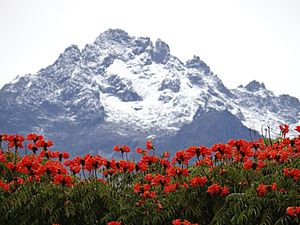
Venezuela's land features include:
- A coastline with several peninsulas and islands.
- The Andes mountain range in the north and northwest.
- Lake Maracaibo (located between mountain chains, on the coast).
- The Orinoco Delta.
- Regions of flat plains and plateaus (called tepui) east of the Orinoco. These form the Guyanas massif in the southeast.
The oldest rock formations in South America are found in the Guyanas highlands. They are also in the mountain ranges of Venezuela.
Coastal Mountain Range
Also known as the Cordillera de la Costa, this range runs along Venezuela's northern coast. It is famous for its lush tropical rainforests and beautiful coastal views. It also has a rich variety of plants and animals. The valleys between the mountain ranges are often fertile. They are home to farms and lively communities. These valleys offer a strong contrast to the rugged mountains that rise from the coast.
Lara-Falcón Highlands
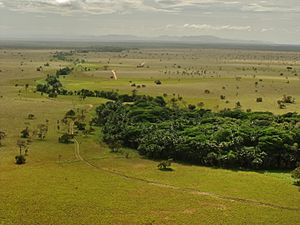
These highlands are in northwestern Venezuela. Their land is made up of plateaus and rolling hills. They are very different from the lowlands and coastal areas around them. The gently sloping plateaus are good for farming. Crops like coffee and cacao are grown here. This region has a semi-dry climate and beautiful scenery. It is important for both farming and tourism.
Lake Maracaibo Lowlands
This area includes the basin of Lake Maracaibo and the plains around the Gulf of Venezuela. There are two different plains here. The northern one is quite dry. The southern one is humid and has many swamps. The land here is mostly flat. There are some higher areas near the lake. Lake Maracaibo itself sits in a low area. It is surrounded by lands rich in oil and good for farming.
The Venezuelan Andes
The Venezuelan Andes are part of the larger Andes mountain range. They have tall peaks, deep valleys, and fertile basins between mountains. This region is dominated by these large mountain ranges. It includes Bolívar Peak, Venezuela's highest mountain. The rugged and beautiful landscapes are shaped by its high-altitude terrain. The unique look of this area comes from the Last Glacial Period. During that time, glaciers moved forward and backward many times. This sculpted the land, creating deep valleys and smooth peaks. The sheltered valleys between the mountains have fertile soil and mild climates. These conditions are great for farming and for people to live.
Los Llanos (The Plains)
Los Llanos, meaning "the plains," are vast flat areas. They are mostly made of sedimentary rock. However, the eastern Llanos have some low plateaus. They also have the Unare depression, formed by erosion. This adds variety to the land. This region often floods during the rainy season. The flat plains turn into a huge wetland. The land here affects the unique ecosystems, including large grasslands and lots of wildlife.
Guiana Shield
The Guiana Shield has diverse landforms. These were shaped by geological processes over millions of years. This region includes flat plains, rugged mountain ranges, foothills, and the famous tepuis. Tepuis are isolated, flat-topped mountains. They rise dramatically from the surrounding land. This unique landscape helps create the region's amazing variety of plants and animals. It also makes it scientifically important.
Orinoco Delta
The Orinoco Delta has a complex system of land and water. It is made up of many channels, islands, and moving sand and mud deposits. While the land might look uniform, it is a very active environment. It is shaped by seasonal flooding and new sediment being deposited. This complex delta supports many kinds of water life. It also supports the lives of Indigenous communities who have adapted to its changing landscapes.
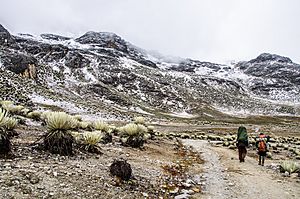
Valleys Across Venezuela
Valleys are very important in Venezuela. Not because they cover a huge area, but because most of the country's people and economic activities are found there. Valleys exist almost everywhere in Venezuela. The only exceptions are the large flat basins of Los Llanos and the Lake Maracaibo depression. They are also absent from the Amazonian plains.
Venezuelan valleys are mainly of two types: river valleys and glacial valleys. River valleys are much more common. Glacial valleys are mostly found in the highest parts of the Andes. Most glacial valleys are remnants from a past geological time, about 10,000 to 12,000 years ago.
The deep, narrow Andean valleys are very different from the wide valleys of Aragua and Carabobo in the Cordillera de la Costa. They are also different from the valleys in the Mesas de Monagas. These examples show that the local land shape helps define different types of valleys. Also, the warm, humid valleys of Guayana are different from the cooler Andean valleys. Both are different from the semi-dry valleys in Lara and Falcón states.
The Andean valleys are very impressive. The mountains around them often rise 3,000 to 3,500 meters above the valley floors. They are also very picturesque in their style of housing, how land is used, and their traditional crafts.
Deserts in Venezuela
Venezuela has many different landscapes and climates, including dry, desert-like areas. The main desert in the country is in the state of Falcon, near the city of Coro. This area is now a protected park called the Médanos de Coro National Park. It is the largest park of its kind in Venezuela, covering 91 square kilometers. The landscape has many cacti and other plants that can survive in dry conditions.
Desert wildlife mostly includes lizards, iguanas, and other reptiles. Less commonly, you might find foxes, giant anteaters, and rabbits. There are also native birds like the sparrowhawk, tropical mockingbird, scaly dove, and crested quail.
Other desert areas in Venezuela include parts of the Guajira Desert in Zulia State. There are also the Médanos de Capanaparo in Santos Luzardo National Park in Apure State. The Medanos de la Isla de Zapara in Zulia State, the Hundición de Yay in Lara State, and the Urumaco Formation in Falcón State are also desert-like.
How Venezuela is Governed
Venezuela is a republic with a president. The president is chosen by a direct vote from all citizens. The president acts as both the head of state and the head of government. A president serves for six years. Since 2009, a president can be re-elected any number of times. The president chooses the vice president and cabinet members. The president can ask the legislature to rethink laws, but the legislature can override these requests with a simple majority vote.
The president can also ask the National Assembly to pass a special law called an enabling act. This act allows the president to make laws by decree in certain areas. To do this, two-thirds of the Assembly must agree. Since 1959, six Venezuelan presidents have been given these powers.
Venezuela has a single-chamber parliament called the Asamblea Nacional (National Assembly). The number of members can change. Each state and the Capital District elect three representatives. More representatives are added based on the state's population. Three seats are set aside for representatives of Venezuela's Indigenous peoples. For the 2011–2016 period, there were 165 seats. All members serve five-year terms.
Citizens can vote starting at age 18. Voting is not required by law.
Venezuela's legal system is based on the Continental Law tradition. The highest court is the Supreme Tribunal of Justice. Its judges are chosen by parliament for a single two-year term. The National Electoral Council (Consejo Nacional Electoral, or CNE) manages elections. It has five main directors chosen by the National Assembly.
Venezuela's Military Forces
The Bolivarian National Armed Forces of Venezuela (Fuerza Armada Nacional Bolivariana, FANB) are the country's unified military forces. They include over 320,150 men and women. They are made up of five parts: the Venezuelan Army, the Venezuelan Navy, the Venezuelan Air Force, the Venezuelan National Guard, and the Venezuelan National Militia.
The main jobs of the armed forces are to protect Venezuela's land, airspace, and islands. They also help with search and rescue missions. In case of a natural disaster, they provide civil protection. All male citizens in Venezuela must register for military service at age 18.
How Venezuela is Divided
Venezuela is divided into 23 states (estados). It also has a capital district for Caracas and special federal dependencies for its islands. These are further split into 335 municipalities (municipios). These municipalities are then divided into over a thousand parishes (parroquias). The states are grouped into nine administrative regions. These regions were created in 1969.
The country can also be seen as having ten geographical areas. Some of these match climate and natural regions. In the north are the Venezuelan Andes and the Coro region. This is a mountainous area in the northwest with several mountain ranges and valleys. East of it are lowlands next to Lake Maracaibo and the Gulf of Venezuela.
The Central Range runs along the coast. It includes the hills around Caracas. The Eastern Range is separated from the Central Range by the Gulf of Cariaco. It covers all of Sucre and northern Monagas. The Insular Region includes all of Venezuela's islands. These are Nueva Esparta and the different Federal Dependencies. The Orinoco Delta forms a triangle covering Delta Amacuro. It extends northeast into the Atlantic Ocean.
Venezuela also claims a historical territory called Guyana Esequiba. This land is managed by Guyana, west of the Esequibo River. In 1966, the British and Venezuelan governments signed an agreement to solve this issue peacefully. A later agreement in 1970 set a deadline to try to resolve it, but it has not been solved yet.
Largest Cities in Venezuela
|
Largest cities or towns in Venezuela
|
||
|---|---|---|
| Rank | Name | Pop. |
| 1 | Caracas | 2,904,376 |
| 2 | Maracaibo | 1,906,205 |
| 3 | Valencia | 1,396,322 |
| 4 | Barquisimeto | 996,230 |
| 5 | Ciudad Guayana | 706,736 |
| 6 | Maturín | 542,259 |
| 7 | Barcelona | 421,424 |
| 8 | Maracay | 407,109 |
| 9 | Cumaná | 358,919 |
| 10 | Barinas | 353.851 |
Tourism in Venezuela
Margarita Island is a top place for tourists. It has modern facilities and beaches perfect for extreme sports. You can also find old castles, fortresses, and churches there.
The Los Roques Archipelago is a group of islands and keys. It is one of the country's main tourist spots. It has beautiful clear beaches. Morrocoy is a national park with small keys very close to the mainland. It has become a very popular tourist spot in the Venezuelan Caribbean.
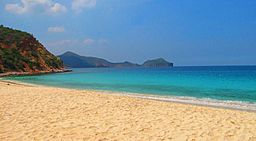
Canaima National Park covers over 30,000 square kilometers (11,583 square miles). It reaches the border with Guyana and Brazil. Because of its size, it is the sixth largest national park in the world. Its steep cliffs and waterfalls create amazing views. This includes Angel Falls, the world's highest waterfall, at 1,002 meters (3,287 feet).
The state of Mérida is another major tourist center. It has many hotels in its capital city and throughout the state. From Mérida city, you can take the longest and highest cable car in the world. It goes up to Pico Espejo, which is 4,765 meters (15,633 feet) high.
World Heritage Sites in Venezuela
Venezuela has three sites recognized by UNESCO as World Heritage Sites.
| Site | Image | Location (state) | Year listed | UNESCO data | Description |
|---|---|---|---|---|---|
| Coro and its Port | 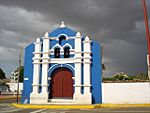 |
Falcón | 1993 | 658; iv, v (cultural) | Founded in 1527 by the Spanish, Coro and its port, La Vela, are early colonial settlements. They still have their original city layout and many historic buildings. The buildings are made using traditional techniques like bahareque (woven bamboo covered in mud), adobe, and rammed earth. Their architecture shows Spanish and Mudéjar styles, with Dutch influences from the late 1600s. In 2005, the site was listed as endangered due to rain damage and new buildings. |
| Canaima National Park | 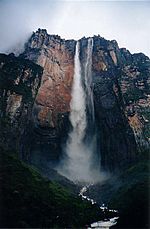 |
Bolívar | 1994 | 701; vii, viii, ix, x (natural) | This national park is famous for its tepuis. These are flat-topped mountains formed over hundreds of millions of years by erosion. Because they are isolated, the tops of the tepuis have many unique animal and plant species. The park also has many waterfalls, including Angel Falls (pictured). It is the world's tallest uninterrupted waterfall, falling about 1000 meters (3,280 feet). |
| Ciudad Universitaria de Caracas | 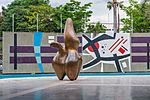 |
Capital District | 2000 | 986; i, iv (cultural) | The University City was built between 1940 and 1960. It was designed by architect Carlos Raúl Villanueva. The complex includes many buildings and art pieces. These include a stadium and the Aula Magna with the Floating Clouds sculpture. It also has a botanical garden. It is a great example of modern architecture adapted for a tropical climate. The Berger des Nuages sculpture is shown. |
Famous Places in Caracas
- Paseo Los Próceres
- Palacio Municipal de Caracas
- National Pantheon
- El Ávila National Park
- Caracas Cathedral
Getting Around: Transport in Venezuela
Venezuela connects to the world mainly by air and sea. Its major airports include Simón Bolívar International Airport near Caracas and La Chinita International Airport near Maracaibo. Key seaports are La Guaira, Maracaibo, and Puerto Cabello. In the south and east, the Amazon rainforest limits cross-border travel. To the west, there is a mountainous border over 2,213 kilometers (1,375 miles) long with Colombia. The Orinoco River links the industrial city of Ciudad Guayana to the Atlantic Ocean.
Venezuela has a small national railway system. It does not have active rail links to other countries. The government tried to expand it, but the project is on hold. This is because Venezuela could not pay the costs.
Several major cities have metro systems. The Caracas Metro has been running since 1983. The Maracaibo Metro and Valencia Metro opened more recently.
Venezuela has a road network of almost 100,000 kilometers (62,000 miles). This places it around 45th in the world. About one-third of these roads are paved.
People and Their Background: Ethnicity in Venezuela
The people of Venezuela come from many different backgrounds. Most of the population is of mixed ethnic ancestry, often called pardo.
A study from 2008 looked at the DNA of Venezuelans. It found that the population is about 60.60% European, 23% Indigenous, and 16.30% African.
Languages Spoken in Venezuela
Most people in Venezuela speak Spanish. However, many other languages are also spoken. The Constitution recognizes over thirty Indigenous languages. These include Wayuu, Warao, and Pemón. Most of these have few speakers, less than 1% of the total population. Wayuu is the most spoken Indigenous language, with 170,000 speakers.
Immigrants also speak their own languages. After Spanish, the most spoken languages are Chinese (400,000 speakers), Portuguese (254,000), and Italian (200,000). Arabic is spoken by communities from Lebanon and Syria. These communities live in places like Isla de Margarita, Maracaibo, Punto Fijo, and Caracas. Portuguese is spoken by the Portuguese community and by many people near Brazil. The German community speaks German. People in Colonia Tovar speak a German dialect called alemán coloniero.
English is the most popular foreign language. Many professionals and academics speak it. This is partly due to foreign oil companies and English being a common international language. In southern towns like El Callao, English is common in folk songs. English was brought to Venezuela by immigrants from Trinidad and other British West Indies islands. A type of Antillean Creole is spoken by a small group in El Callao and Paria. Italian is taught in private schools. Other languages spoken by large communities include Basque and Galician.
Religion in Venezuela
Religion in Venezuela (2011) Catholic (71%) Protestant (17%) No religion (7%) Other religion (3%) No answer (1%)
According to a 2011 survey, 88% of Venezuelans are Christian. Most of them are Roman Catholic (71%). The remaining 17% are Protestant, mainly Evangelicals. About 8% of Venezuelans say they have no religion. Almost 3% follow other religions, with 1% practicing Santería.
There are also smaller but important communities of Muslims, Druze, Buddhists, and Jewish people. The Muslim community has over 100,000 people. They are mainly of Lebanese and Syrian descent. They live in places like Nueva Esparta state and Caracas. Venezuela has the largest Druze communities outside the Middle East, estimated at around 60,000 people. Buddhism is practiced by over 52,000 people, mostly Chinese, Japanese, and Korean.
The Jewish community has become smaller in recent years. This is due to economic challenges. The population went from 22,000 in 1999 to less than 7,000 in 2015.
Education in Venezuela
In 2008, 95.2% of adults in Venezuela could read and write. Venezuela has several universities. The most well-known include the Central University of Venezuela, founded in 1721, the University of Zulia, and the University of the Andes.
Many Venezuelan university graduates now look for opportunities abroad. Over 1.35 million college graduates have left the country since the start of the Bolivarian Revolution. It is thought that almost 12% of Venezuelans live outside the country. Ireland has become a popular place for students. In 2013, more than half of all medical graduates had left Venezuela.
By 2018, over half of all Venezuelan children had left school. About 58% of students nationwide quit. In areas near the borders, more than 80% of students left. Across the country, about 93% of schools do not meet basic requirements. Also, 77% do not have basic services like food, water, or electricity.
Venezuelan Culture
Venezuela's culture is a mix of three main groups: Indigenous Venezuelans, Africans, and the Spanish.
Africans brought many musical influences, especially the use of drums. The Spanish influence is very strong because of the colonization process. Spanish influences can be seen in the country's buildings, music, religion, and language.
Venezuela's culture was also enriched by immigrants from India and Europe in the 1800s, especially from France. More recently, immigrants from the United States, Spain, Italy, and Portugal have added to this rich cultural mix.
Architecture in Venezuela
Carlos Raúl Villanueva was a very important Venezuelan architect of the modern era. He designed the Central University of Venezuela, which is a World Heritage Site, and its Aula Magna. Other famous buildings include the Capitolio, the Baralt Theatre, and the Teresa Carreño Cultural Complex.
In Venezuela, early humans started building useful structures around 1000 B.C. to 15th century A.D. This period is known as the "Neo-Indian" era. Neo-Indian architecture included things like agricultural terraces and stone-lined vaults called mintoyes. These were used as tombs and for storing crops. Venezuelan colonial architecture began in the 1500s. This was when Venezuela became a colony of the Spanish Empire. This style lasted until 1810, when Venezuela started its fight for independence.
Art in Venezuela
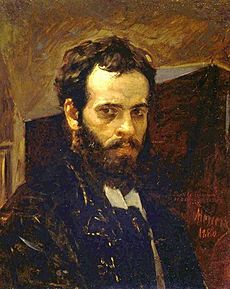
Venezuelan art first focused on religious themes. But in the late 1800s, artists began to show historical and heroic scenes of the country's fight for independence. Martín Tovar y Tovar led this change. Modernism became popular in the 1900s. Famous Venezuelan artists include Arturo Michelena, Cristóbal Rojas, and Armando Reverón. There are also kinetic artists like Jesús Soto, Gego, and Carlos Cruz-Diez. Contemporary artists include Marisol and Yucef Merhi.
Music in Venezuela
The traditional music styles of Venezuela are shown by groups like Un Solo Pueblo and Serenata Guayanesa. The national musical instrument is the cuatro.
The Zulian gaita is also very popular, especially during Christmas. The national dance is the joropo.
Venezuela's music and dances are rich and varied due to its mix of cultures. Examples include calipso, bambuco, fulía, and songs for grinding corn or washing clothes. Teresa Carreño was a world-famous piano player in the 1800s. Recently, Venezuela has produced great classical music performances. The Simón Bolívar Youth Orchestra has performed in many European concert halls. They received honors, including at the 2007 London Proms. This orchestra is a top example of El Sistema. This is a government-funded music education program that is now copied in other countries.
In the early 2000s, a movement called "Movida Acústica Urbana" started. Musicians tried to preserve national traditions. They created new songs using traditional instruments. Some groups in this movement are Tambor Urbano, Los Sinverguenzas, C4Trío, and Orozco Jam.
Sports in Venezuela
The exact start of baseball in Venezuela is not clear. But it was played in the country by the late 1800s. In the early 1900s, North American immigrants came to Venezuela to work in the oil industry. They helped make baseball more popular. By the 1930s, baseball's popularity grew even more. This led to the creation of the Venezuelan Professional Baseball League (LVBP) in 1945. Soon, baseball became the country's most popular sport.
Baseball's popularity makes Venezuela unique among its South American neighbors. In most of the continent, soccer (association football) is the main sport. However, soccer and basketball are also popular sports in Venezuela. Venezuela hosted the 2012 Basketball World Olympic Qualifying Tournament and the 2013 FIBA Basketball Americas Championship. These events took place in the Poliedro de Caracas.
Soccer, led by the Venezuela national football team, is also gaining popularity. The sport gets more attention during the World Cup. Venezuela is set to host the Copa América every 40 years.
Venezuela is also home to former Formula 1 driver, Pastor Maldonado. He has helped make Formula 1 more popular in the country.
At the 2012 Summer Olympics, Rubén Limardo won a gold medal in fencing.
In winter sports, Cesar Baena has represented Venezuela since 2008 in Nordic Skiing. He was the first South American skier to compete in a FIS Cross Country Ski World Cup in Düsseldorf in 2009.
Official Holidays in Venezuela
| Date | Local name | English name |
|---|---|---|
| January 1 | Día de Año Nuevo | New Year's Day |
| January 6 | Día de Reyes | Epiphany |
| Monday and Tuesday before Ash Wednesday | Carnaval | Carnival |
| From Palm Sunday to Easter (movable) | Semana Santa | Holy Week |
| 30 days after Easter (movable) | Día de la ascención | Feast of the Ascension |
| March 19 | Día de San José | Saint Joseph's Day |
| April 19 | Diecinueve de abril | Anniversary of the Beginning of the Independence movement/19 April |
| May 1 | Día del Trabajador | Labor Day |
| Second Sunday of May (movable) | Día de las Madres | Mother's Day |
| Third Sunday of June (movable) | Día de los Padres | Father's Day |
| Approx. 60 days after Easter | Corpus Christi | Corpus Christi |
| June 24 | Día de San Juan Bautista y Aniversario de la Batalla de Carabobo | Feast of Saint John the Baptist and the Anniversary of the Battle of Carabobo |
| June 29 | Día de San Pedro y San Pablo | Feast of Saint Peter and Saint Paul |
| July 5 | Cinco de julio | Independence Day |
| July 24 | Natalicio del Libertador | Birth of Simón Bolívar |
| August 15 (usually) | Día de la Asunción | Assumption Day |
| Second Monday of September | Aparicion del Virgen del Coromoto | Feast of Our Lady of Coromoto |
| October 12 | Día de la Resistencia Indígena | Day of Indigenous Resistance |
| November 1 | Día de Todos los Santos | All Saints' Day |
| December 8 | Inmaculada Concepción | Immaculate Conception |
| December 24 | Nochebuena | Christmas Eve |
| December 25 | Navidad | Christmas |
| December 31 | Nochevieja | New Year's Eve |
Popular Holidays in Venezuela
| Date | Local name | English name |
|---|---|---|
| January 14 | Día de la Divina Pastora | Feast of the Divina Pastora |
| January 15 | Día del Maestro | Teachers' Day |
| February 12 | Día de la Juventud | Youth Day |
| February 20 | Dia de la Federacion | Federation Day |
| March 8 | Dia Internacional de la Mujer | International Women's Day |
| March 21 | Día del abolición de la esclavitud | Slavery Abolition Anniversary |
| March 28 | Día Nacional del Patrimonio Cultural | National Cultural Patrimonies Day |
| March 31 | Aniversario del fundacion del San Cristóbal | Foundation anniversary Day of San Cristóbal, Táchira |
| May 3 | Día del Cruz del Mayo | Fiesta de las Cruces |
| May 25 | Día del Himno Nacional | National Anthem Day |
| June 27 | Día del Periodista y Aniversario de la instauración del Decreto de Instrucción pública gratuita y obligatoria | Journalists' Day and the Anniversary of the 1872 Public Education Decree |
| Third Sunday of July (movable) | Dia del niño | Children's Day |
| July 24 | Dia de la Armada Nacional | Navy Day and the anniversary of the Battle of Lake Maracaibo |
| July 25 | Aniversario del fundacion del Caracas | Caracas City Foundation Day |
| August 3 | Día de la Bandera | Flag Day |
| August 4 | Día de la Guardia Nacional | National Guard Day |
| September 8 | Día del Virgen del Valle | Birth of the Blessed Virgin Mary, feast of the Virgen del Valle |
| September 24 | Día del Virgen de las Mercedes | Feast of the Our Lady of Mercy |
| November 2 | Día de los fieles difuntos | All Souls' Day |
| November 17 to November 19 | Feria de la Chinita | Feria of La Chinita |
| November 21 | Día del estudiante universitario | University Students' Day |
| December 8 | Dia de la Lealtad | Loyalty Day |
| December 10 | Día de la Aviacion Militar | Venezuelan Air Force Day |
| December 17 | Aniversario de la muerte de Libertador Simón Bolívar | Simón Bolívar Memorial Day |
Fun Facts About Venezuela
- Venezuela is the 33rd largest country in the world.
- Most Venezuelans live in cities in the north and in the capital.
- The country has the world's largest known oil reserves. It has been a leading exporter of oil.
- Venezuela is home to 1,417 bird species, with 48 found only there. The yellow-orange Venezuelan troupial is the national bird.
- Venezuela has a national universal health care system.
Images for kids
-
Cult image sculpted in ceramic, Los Roques Archipelago.
-
The German Welser Armada exploring Venezuela. German Welsers ruled Venezuela from 1528 to 1546. Painting of 1560 by Hieronymus Köler.
-
Amerindian population of Venezuela in 2011.
-
National Assembly of Venezuela building
-
La Casona presidential residence in Caracas, now a museum.
-
A Sukhoi Su-30MKV of the Venezuelan Air Force
-
The historic center of Coro, a UNESCO World Heritage Site, is an example of Spanish colonial architecture in Venezuela.
-
Basilica of Our Lady of Chiquinquirá, built between 1686 and completed in 1858, where is kept the colonial image of the Virgin of Chiquinquirá, in Maracaibo.
-
St. Martin of Tours Catholic Church in Colonia Tovar, a German-style town built in the 1840s-1850s by German immigrants in Venezuela.
-
The Guanaguanare dance, a popular dance in Portuguesa State.
-
Venezuela national football team, popularly known as the "Vinotinto"
-
Victoria Lagoon, Mérida State
-
Valencia Lake, formerly praised by Alexander von Humboldt for its beauty, is massively polluted due to the countless sewage systems pouring residuals.
See also
 In Spanish: Venezuela para niños
In Spanish: Venezuela para niños




